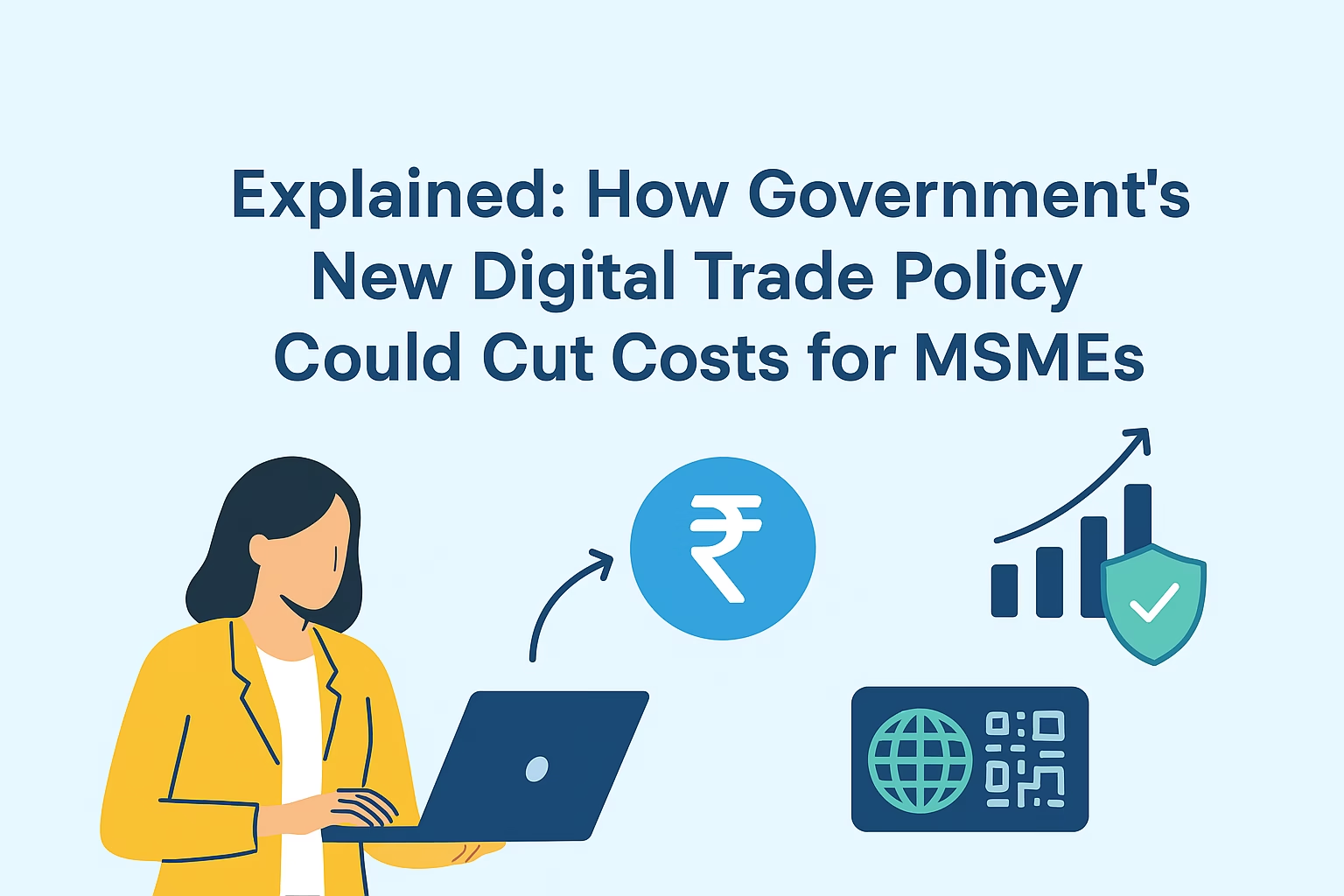Introduction
Micro, Small, and Medium Enterprises (MSMEs) are often called the backbone of the Indian economy. From textiles in Surat to handicrafts in Jaipur, from IT services in Bengaluru to manufacturing units in Noida, MSMEs contribute over 30% of India’s GDP and nearly half of its exports.Yet, despite this importance, most MSMEs face high operational costs, compliance challenges, and barriers in global trade. To address these gaps, the Government of India has rolled out the New Digital Trade Policy 2025, which promises to make cross-border trade simpler, faster, and more cost-efficient for MSMEs.

In this article, we’ll explain what the new Digital Trade Policy means, how it works, and how it could cut costs for Indian MSMEs.
What Is the Government’s New Digital Trade Policy 2025?
The Digital Trade Policy 2025 is a comprehensive framework designed to digitize documentation, reduce manual paperwork, introduce digital customs processes, and support MSMEs with tech-driven solutions in exports and imports.
The policy aligns with India’s “Digital India” and “Atmanirbhar Bharat” vision and aims to integrate MSMEs into the global trade ecosystem with lower costs and faster processes.
Key highlights of the policy include:
- 📄 Paperless documentation through digital platforms
- ⚡ Single-window clearance for trade approvals
- 🌍 Integration with international trade platforms
- 📊 AI-driven compliance checks to reduce delays
- 💰 Financial support & tax incentives for MSMEs adopting digital tools
Why MSMEs Struggle With Trade Costs Today
Before diving into the benefits, let’s understand the pain points MSMEs face under the current system:
- High paperwork costs – Hiring agents and preparing physical documents adds extra costs.
- Delays at customs – Manual checks and multiple clearances often slow down exports.
- Hidden fees – From certification charges to logistics surcharges, MSMEs pay more than large companies.
- Global competition – Indian MSMEs often lose out to competitors in Vietnam or Bangladesh due to higher compliance costs.
- Limited access to digital tools – Many MSMEs still rely on outdated systems, making trade less efficient.
Income Tax Bill 2025 Delayed—Is This a Political Strategy or Bureaucratic Hurdle?
How the Digital Trade Policy Will Cut Costs for MSMEs
Here’s where the new reforms bring relief:
1. Paperless Trade = Direct Savings
MSMEs currently spend ₹10,000–₹25,000 per shipment on documentation and agents. With the new digital portal, these costs will reduce drastically.
👉 Example: A textile exporter from Tirupur can now upload invoices digitally, get approvals in hours instead of days, and save on agent fees.
2. Single-Window Clearance = Faster Approvals
Instead of running between DGFT, Customs, GST, and Banks, MSMEs will now have one unified platform for all trade-related approvals.
This means lower compliance costs and faster time-to-market, giving MSMEs an edge over global competitors.
3. AI-Powered Compliance = Fewer Penalties
AI-driven checks will automatically flag missing documents or errors before submission, saving MSMEs from penalties and delays.
👉 This reduces the risk of shipment rejections and unnecessary fines, which often eat into MSME profits.
4. Global Market Access at Lower Costs
The policy promotes integration with international trade systems like WTO digital trade standards. This ensures Indian MSMEs can export faster to Europe, US, and ASEAN countries without additional compliance costs.
5. Financial Incentives & Digital Support
The government will also provide:
- 💳 Low-cost loans for MSMEs to adopt digital tools
- 📈 Tax rebates on using digital trade platforms
- 📚 Training programs to help MSMEs go digital
Real-Life Impact: A Case Study Example
Let’s say Ananya Handicrafts, a small Jaipur-based MSME, exports wooden handicrafts.
- Before Policy: They spent nearly ₹40,000 per shipment on compliance, paperwork, and delays.
- After Policy: With digital platforms, their compliance costs dropped to ₹10,000–₹15,000, saving almost 60% per export order.
This kind of saving is game-changing for small businesses, allowing them to price more competitively and expand globally.
Challenges MSMEs May Face in Adapting
While the policy is promising, MSMEs may still face hurdles such as:
- Low digital literacy in rural MSMEs
- Need for training on digital trade platforms
- Initial transition costs for adopting new software
- Dependence on stable internet connectivity
👉 However, government-led capacity-building programs and subsidies are expected to reduce these challenges.
Why This Policy Matters for India’s Future
- 🌍 Boosts India’s exports by making MSMEs globally competitive
- 🏭 Strengthens MSMEs, which employ 11 crore+ people in India
- 📉 Cuts transaction costs, supporting the government’s ease of doing business goal
- 💡 Drives digital transformation, aligning with India’s vision of becoming a $5 trillion economy
FOLLOW TIME OF HINDUSTAN ON FB
Conclusion: A Turning Point for MSMEs
The Government’s Digital Trade Policy 2025 is more than just a reform — it’s a cost-cutting revolution for MSMEs. By reducing paperwork, digitizing compliance, and supporting small businesses with incentives, this policy could help millions of Indian MSMEs save money, expand globally, and compete with international players.
👉 For small business owners, this is the right time to adapt, adopt digital tools, and leverage the benefits of the new trade ecosystem.
